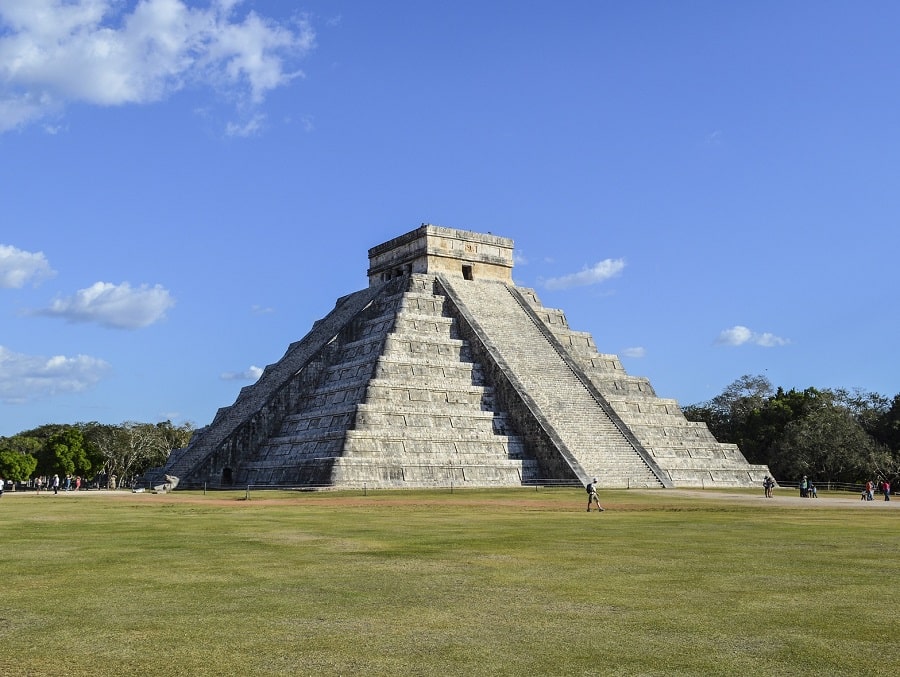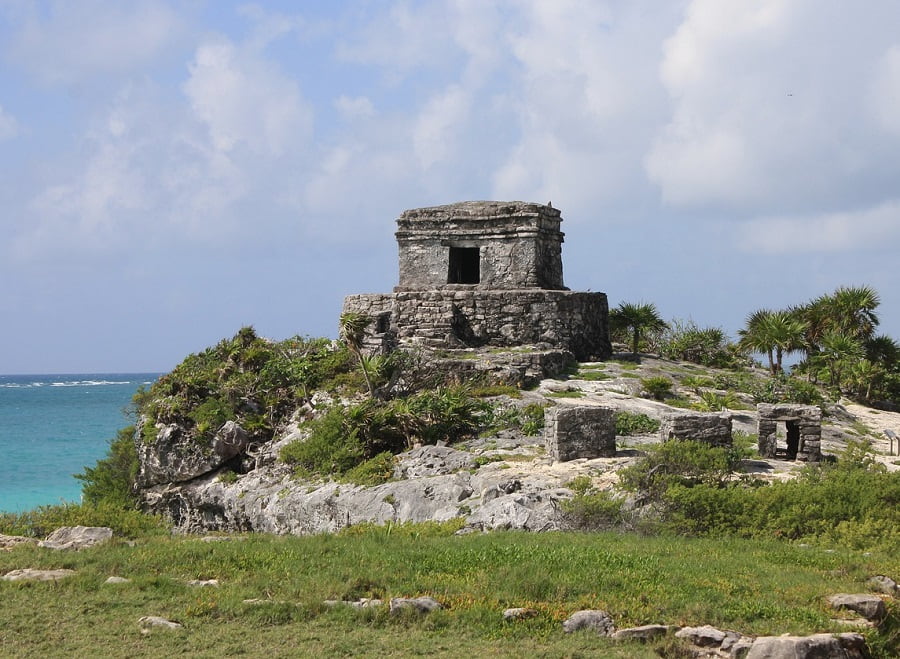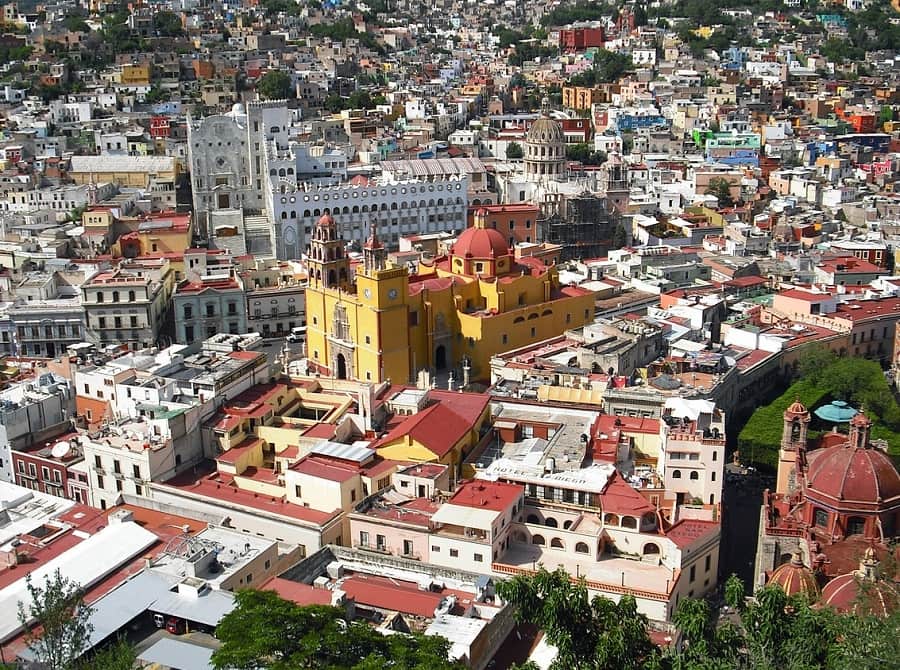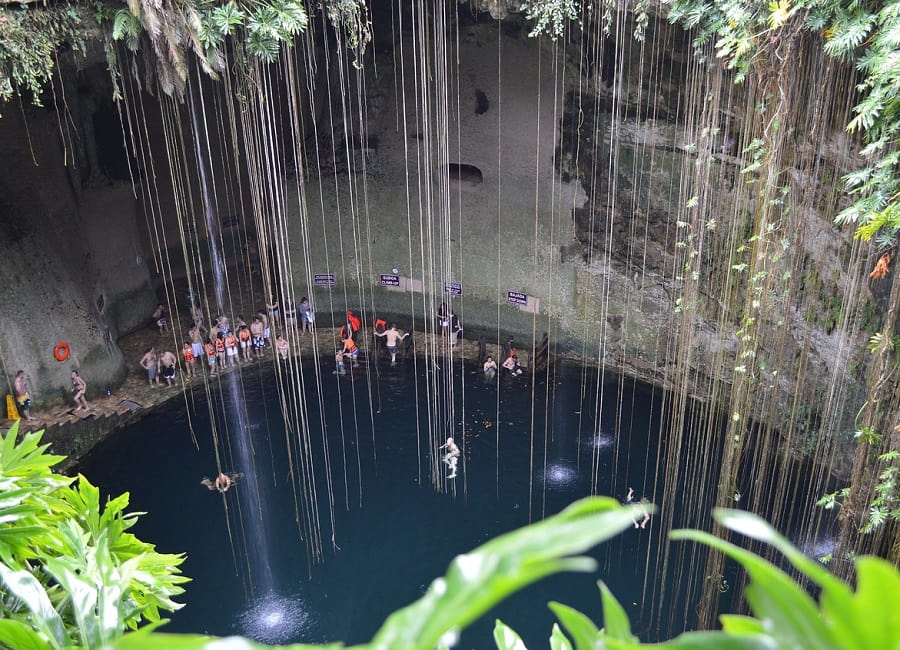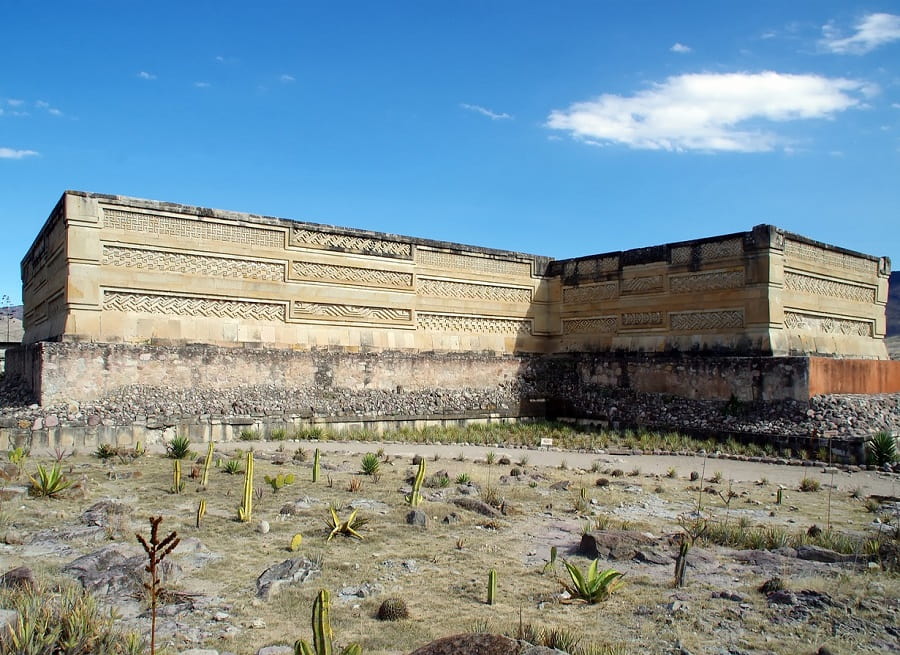18 Most Famous Landmarks in Mexico
Last Updated on 21st July 2023 by admin
Mexico is a country that boasts a rich cultural heritage, filled with magnificent landmarks that captivate visitors from around the world. From ancient ruins to architectural marvels, Mexico offers a diverse range of iconic attractions that showcase its history, artistry, and natural beauty. In this article, we will embark on a virtual journey to discover the 18 most famous landmarks in Mexico, delving into their historical significance, architectural brilliance, and cultural allure.
1) Chichén Itzá
Chichén Itzá, one of the New 7 Wonders of the World, stands as a captivating testament to the ancient Mayan civilization’s architectural prowess. This ancient monument, El Castillo, also known as the Temple of Kukulcan, is situated on the Yucatán Peninsula in Mexico and attracts tourists with its majestic pyramid.
As you step back in time and explore Chichén Itzá, you’ll be mesmerized by the intricate carvings, stone columns, and observatory that offer a glimpse into the Mayan culture and astronomical knowledge. The mathematical precision and alignment of the structures with celestial events showcase the Mayans’ profound understanding of the cosmos.
El Castillo, with its unique design, serves as a celestial calendar, marking the equinoxes with a serpent-like shadow descending its steps. The acoustic wonder of the Great Ball Court and the mysterious Cenote Sagrado add to the enigma of Chichén Itzá.
This archaeological marvel leaves visitors in awe of the Mayan mysteries and is one of the famous landmarks in Mexico. Attracting millions of visitors each year to explore and marvel at the ancient ruins and mysteries of this iconic archaeological site.
2) Teotihuacán
Teotihuacán, an awe-inspiring ancient city located near Mexico City, holds the secrets of a once-thriving civilization. Often referred to as the “City of the Gods,” Teotihuacán’s massive pyramids and monumental structures evoke a sense of grandeur and mystique.
The Pyramid of the Sun and the Pyramid of the Moon dominate the landscape, inviting visitors to ascend their ancient steps for breathtaking views of the surrounding Avenue of the Dead. The city’s layout reflects an advanced urban planning system, with well-organized streets and neighborhoods.
As you explore Teotihuacán, the intricate murals and carvings, such as the Feathered Serpent Pyramid, offer insights into the religious beliefs and artistic talents of its inhabitants. Teotihuacán was a flourishing center of commerce, culture, and religious practices.
Strolling through the ancient streets, one can’t help but feel the palpable energy and significance of this once-thriving metropolis. Teotihuacán continues to captivate modern-day explorers, providing a glimpse into the world where gods walked among mortals, leaving an enduring mark on Mexico’s cultural heritage.
3) Palenque
The ancient Mayan city of Palenque is a true gem and one of the famous landmars in Mexico, hidden in the lush jungle of Chiapas. This archaeological site transports visitors back in time, offering a captivating glimpse into the cultural and architectural brilliance of the Mayans.
The main attraction at Palenque is the Temple of the Inscriptions, an impressive pyramid housing the tomb of the famous Mayan ruler, Pakal. Intricate carvings and hieroglyphs on the temple’s walls depict the ruler’s fascinating life story.
The Palace, another striking structure, showcases the Mayan’s advanced engineering and artistic skills. Its intricate stone carvings and well-preserved courtyards stand as a testament to the civilization’s sophisticated urban planning. As you wander through the jungle-clad ruins, the atmosphere feels both mystical and serene.
The surrounding natural beauty enhances the sense of wonder and discovery at Palenque. For history enthusiasts and adventure seekers, Palenque is an archaeological treasure trove, offering a rare opportunity to connect with Mexico’s ancient past and immerse oneself in the legacy of the Mayan civilization.
4) Mexico City Metropolitan Cathedral
The Mexico City Metropolitan Cathedral, an awe-inspiring architectural marvel, graces the Zócalo with its grandeur and historical significance. As one of the largest and oldest cathedrals in the Americas, it bears witness to the enduring faith and cultural heritage of Mexico.
The cathedral’s façade, adorned with intricate sculptures and carvings, serves as a visual delight, inviting admiration from passersby and worshippers alike. Inside, its vast interior with soaring ceilings and elaborate altars creates an atmosphere of reverence and spirituality.
Stepping into the cathedral’s hallowed halls feels like embarking on a journey through time, as its construction spans centuries, blending various architectural styles. It stands as a living testament to Mexico’s history, having withstood the test of time and witnessed significant historical events.
The Mexico City Metropolitan Cathedral continues to be a vibrant spiritual hub, attracting pilgrims and visitors seeking solace, reflection, and a connection with the nation’s rich religious heritage. It remains an integral part of Mexico City’s cultural landscape, forever enshrined as a symbol of faith, resilience, and reverence.
5) Tulum
Tulum, a mesmerizing archaeological site perched on the cliffs overlooking the turquoise Caribbean Sea, offers a unique and awe-inspiring experience that marries history with natural beauty. This ancient Mayan city, once a bustling port and trading hub, stands as a testament to the ingenuity and cultural richness of the Mayan civilization.
As visitors explore Tulum’s well-preserved ruins, they are treated to breathtaking views of the shimmering sea below, making it one of the famous landmarks in Mexico. The Castillo, the site’s iconic pyramid, serves as a striking focal point, where ancient Mayans once gazed out to sea.
The combination of ancient structures and the picturesque coastline creates a magical ambiance, making Tulum a favorite destination for travelers seeking to immerse themselves in Mexico’s pre-Columbian past while basking in the natural splendor of the Caribbean.
Tulum’s unique blend of history and coastal allure offers an unforgettable experience, allowing visitors to walk in the footsteps of the ancient Mayans while soaking in the beauty of the Mexican Caribbean.
6) Guanajuato
Guanajuato, a colonial gem nestled in the heart of Mexico, enchants visitors with its colorful architecture, rich history, and vibrant cultural scene. This UNESCO World Heritage site is a testament to the colonial era’s grandeur, with its cobblestone streets, ornate churches, and splendid plazas.
The city’s historical significance dates back to the silver mining boom of the 16th century, which left behind a legacy of opulent colonial buildings and underground tunnels that now serve as one of the famous tourist attractions in Mexico. The iconic Callejón del Beso (Alley of the Kiss) is a charming alley with a romantic legend that lures couples from all over.
Guanajuato’s thriving arts scene, including the famous International Cervantes Festival, adds to its allure, making it a hub for artists and performers. Its picturesque surroundings, nestled among rolling hills, contribute to the city’s enchanting atmosphere.
For travelers seeking a journey through Mexico’s colonial past and a taste of its vibrant cultural present, Guanajuato is an irresistible destination that leaves a lasting impression.
7) Monte Albán
Monte Albán, perched atop a hill overlooking the Oaxaca Valley in Mexico, is an extraordinary archaeological site and a testament to the ingenuity of the ancient Zapotec civilization. This ancient city served as the capital of the Zapotec empire for centuries, and its well-preserved ruins offer a captivating glimpse into the civilization’s cultural and architectural achievements.
Dating back over 2,500 years, Monte Albán’s expansive complex features grand plazas, pyramids, and intricate stone carvings. The Great Plaza, flanked by impressive platforms and temples, stands as the heart of the site and once hosted important ceremonies and gatherings.
The site’s unique celestial observatory, known as the Building of the Dancers, reflects the Zapotec’s advanced understanding of astronomy and their close connection to the cosmos.
Monte Albán’s historical and cultural significance, combined with its breathtaking views of the Oaxaca Valley, make it a famous destination for history enthusiasts and travelers seeking to unravel the mysteries of Mexico’s ancient past.
8) Coba
Coba, an ancient Mayan city hidden in the jungles of Mexico’s Yucatán Peninsula, beckons adventurous travelers on a bicycle expedition through history. This archaeological site offers a unique and thrilling opportunity to explore the Mayan ruins amidst the lush wilderness.
Renting a bicycle to traverse the site is an exciting way to soak in the natural beauty and immerse oneself in the mysterious world of the Mayans. As you pedal along the ancient pathways, you’ll encounter impressive structures like the Nohoch Mul Pyramid, the tallest in the Yucatán region, offering panoramic views from its summit.
The extensive network of paths allows you to discover hidden temples and stelae scattered throughout the jungle, providing a sense of discovery and adventure. Coba’s off-the-beaten-path appeal ensures a more intimate experience with the ruins, making it a favorite destination for explorers seeking a deeper connection with Mexico’s ancient heritage.
For an upcoming journey filled with thrill and historical enchantment, Coba promises an unforgettable bicycle adventure through the verdant jungles, unraveling the mysteries of the Mayan civilization along the way.
9) Museo Nacional de Antropología
A testimony to the nation’s rich cultural past is the Museo Nacional de Antropologa, which is located in Chapultepec Park in Mexico City. This iconic museum offers a captivating journey through Mexico’s indigenous civilizations and showcases their art, history, and traditions.
Designed by architect Pedro Ramírez Vázquez, the museum’s circular courtyard, inspired by the Aztec sun stone, welcomes visitors with an aura of grandeur. Inside, the main halls are home to an extensive collection of archaeological artifacts, ancient art, and ethnographic exhibits, providing profound insights into Mexico’s past.
The museum’s crown jewel is the Aztec calendar stone, an intricate and massive stone carving that captures the complexity of the Aztec calendar system. Other remarkable exhibits include the famous “Piedra del Sol” and the colossal Olmec heads and it is also listed in top 10 largest museums in the world.
The Museo Nacional de Antropologa is a must-go destination for anybody who wants to delve into Mexico’s ancient history and connect with the varied and vivid fabric of its indigenous cultures because of its rich historical and cultural relevance.
10) Chapultepec Castle
Perched majestically on Chapultepec Hill in Mexico City, Chapultepec Castle is a historic marvel that offers a fascinating glimpse into Mexico’s past and provides visitors with breathtaking views of the city below.
Originally built in the 18th century as a residence for Spanish viceroys, the castle later served as an imperial residence for Emperor Maximilian I and Empress Carlota during the Second Mexican Empire. Today, it houses the National Museum of History, showcasing exhibits that chronicle Mexico’s storied past.
As you ascend to the castle’s hilltop location, you’re greeted by the grandeur of its neo-romantic architecture. Inside, opulent halls, richly decorated chambers, and ornate furnishings transport you back in time to Mexico’s regal history.
The castle’s grounds are equally enchanting, featuring lush gardens and serene pathways, making it one of the famous landmarks in Mexico. The highlight is the balcony, known as the “Mirador,” offering panoramic views of Mexico City’s skyline and the sprawling Chapultepec Park below.
11) Hierve el Agua
Hierve el Agua, a stunning natural wonder in Oaxaca, Mexico, is nature’s own version of infinity pools and making it fascinating things in the world. This breathtaking site features petrified mineral formations that resemble cascading waterfalls, creating a mesmerizing spectacle amidst the rugged landscape.
The name “Hierve el Agua” translates to “the water boils,” but the pools are not heated; rather, the minerals in the water create the appearance of frozen waterfalls. The mineral-rich springs feed the pools, creating a series of terraced, turquoise-colored basins that seem to stretch infinitely into the horizon.
The two main formations, known as the “Cascada Chica” and “Cascada Grande,” are a sight to behold, offering a unique and tranquil spot to take in the awe-inspiring beauty of nature. Beyond the pools, Hierve el Agua’s panoramic views of the surrounding valleys and mountains add to its allure, making it a favorite destination for nature enthusiasts and photographers seeking to capture the essence of Mexico’s natural wonders.
For a rejuvenating escape into nature’s artistry, Hierve el Agua beckons with its ethereal beauty and soothing ambiance, providing a once-in-a-lifetime experience in Mexico’s enchanting landscapes.
12) Xcaret
Xcaret is an amazing eco-archaeological park located along Mexico’s Riviera Maya. It is a magnificent place where nature and culture blend to provide tourists a captivating experience and making it one of the famous landmarks in Mexico.
This ecological paradise offers a myriad of activities that celebrate Mexico’s rich heritage and natural beauty. Explore ancient Mayan ruins and learn about the region’s indigenous past. Discover the underground rivers, crystal-clear cenotes, and lush jungles, immersing yourself in the wonders of Mother Nature.
At Xcaret, cultural performances and traditional ceremonies showcase Mexico’s vibrant folklore and traditions. From the lively Papantla Flyers to the mesmerizing Voladores de Papantla ritual, every moment is a celebration of the country’s cultural tapestry.
For animal lovers, Xcaret’s wildlife encounters, such as swimming with dolphins or observing sea turtles, offer an up-close connection with the region’s diverse fauna. End your day at Xcaret’s stunning beach, basking in the golden sunset over the Caribbean Sea, and revel in the harmony of nature’s splendor and Mexico’s cultural heritage.
13) Cenote Ik Kil
Cenote Ik Kil, located in Mexico’s Yucatán Peninsula, is a captivating sinkhole that entices travelers with its natural beauty and mystical allure. Surrounded by lush greenery and hanging vines, this cenote offers a surreal oasis-like setting. Descending through a carved stairway, visitors are welcomed by crystal-clear waters that invite them to take a refreshing dip.
The cenote’s unique geological features, such as underwater caves and rock formations, make it a popular spot for snorkelers and scuba divers. Its historical significance as a sacred site for the ancient Maya civilization adds cultural depth to the experience.
Cenote Ik Kil’s popularity as a tourist destination is well-deserved, providing well-maintained facilities and a comfortable setting for all visitors. Whether you’re swimming in its azure waters or simply basking in its tranquility, Cenote Ik Kil offers an unforgettable and enchanting adventure into the heart of Mexico’s natural wonders.
14) The Angel of Independence
The Angel of Independence, or El Ángel, is a majestic monument in the heart of Mexico City’s Paseo de la Reforma. Built in 1910 to celebrate Mexico’s centennial of independence, this towering bronze statue portrays the Winged Victory, holding a laurel wreath and a broken chain, symbolizing freedom.
Perched on a grand pedestal adorned with intricate reliefs depicting historical events, the Angel of Independence is a symbol of the nation’s resilience and progress. Visitors can climb a spiral staircase inside the monument for breathtaking views of the city.
From national celebrations to gatherings and protests, the Angel of Independence has witnessed pivotal moments in Mexico’s history. Illuminated at night, it exudes a radiant charm.
This iconic monument embodies Mexico’s vibrant spirit and determination, leaving a lasting impression on both locals and tourists. It is one of the most famous landmarks in Mexico, stands as a proud symbol of the country’s hard-fought independence and enduring pride.
15) Museo Frida Kahlo
The Frida Kahlo Museum, also known as the Museo Frida Kahlo, is an amazing look into the life of one of Mexico’s most famous painters and is situated in Mexico City’s Coyoacán neighbourhood. The museum, housed in the “Casa Azul” where Frida Kahlo was born and lived, provides an intimate look into the life and artistry of this iconic figure.
The Casa Azul itself is a visual delight, with its cobalt blue walls and traditVisitors are greeted with a vibrant and colorful atmosphere, surrounded by Frida’s personal belongings, artwork, and studio. Her famous self-portraits, diaries, and many famous paintings offer insight into her emotional struggles, her relationship with Diego Rivera, and her deep connection to Mexican culture and heritage
The Casa Azul itself is a visual delight, with its cobalt blue walls and traditional Mexican decor. As visitors explore the rooms, they are transported back in time to experience Frida’s life and creativity.
The Museo Frida Kahlo is a tribute to her lasting legacy, providing an opportunity to appreciate the resilience and brilliance of an artist who defied norms and left an indelible mark on the art world. For art enthusiasts and admirers of Frida Kahlo, this museum is an essential pilgrimage to understand the depth and significance of her impact on Mexican and global art.
16) El Tajin
El Tajin, located in the state of Veracruz, Mexico, is an awe-inspiring archeological site that offers a glimpse into the enigmatic world of the pre-Columbian civilization. Designated as a UNESCO World Heritage site, El Tajin showcases the remarkable architectural and artistic achievements of the ancient Totonac people and one of the famous landmarks in Mexico.
The site’s iconic Pyramid of the Niches stands as a testament to the Totonac’s ingenuity and sophisticated engineering. With its unique stepped design and intricate niches, the pyramid exudes a sense of mystery and wonder. Visitors can climb to the top for panoramic views of the surrounding landscape.
El Tajin’s Ballgame Court, adorned with stone reliefs, hints at the ancient ceremonial games that were part of the Totonac culture. The site also features impressive plazas, temples, and sculptures, all reflecting the complex spiritual beliefs and artistic talents of the civilization.
Beyond its historical significance, El Tajin’s lush setting amidst the Veracruz jungle adds to the allure of the site. As visitors explore this ancient marvel, they are transported back in time, imagining the vibrant life and cultural richness that once thrived within these sacred grounds. For history enthusiasts and adventurers alike, El Tajin is a famous tourist attraction that offers a captivating glimpse into Mexico’s pre-Columbian past.
17) Palacio de Bellas Artes
The Palacio de Bellas Artes, also known as the Palace of Fine Arts, is a cultural treasure that exudes majesty and creative brilliance. It is tucked away in the centre of Mexico City. This iconic building is a harmonious blend of neoclassical and Art Nouveau architectural styles, making it a stunning masterpiece and become one of the famous landmarks in Mexico in itself.
The Palacio de Bellas Artes serves as the principal venue for Mexico’s most famous cultural events, from opera and ballet to classical concerts and art exhibitions. Its opulent interior features magnificent murals by famous Mexican artists such as Diego Rivera, David Alfaro Siqueiros, and José Clemente Orozco, depicting the nation’s history and culture.
The main theater is a sight to behold, with its lavish décor and exquisite stained glass curtain by Tiffany & Co. The theater’s acoustics are so excellent that some consider it to be one of the best places in the world to see musical perfor
Outside, the building is adorned with bronze sculptures and elaborate ornamentation, captivating passersby and adding to the allure of the surrounding Alameda Central Park.
18) Mitla
Located in the state of Oaxaca, Mexico, Mitla is an archaeological site that offers a fascinating glimpse into the ancient world of the Zapotec civilization. Designated as a UNESCO World Heritage site, Mitla showcases the impressive architectural achievements and intricate stonework of this ancient civilization.
The site’s name, “Mitla,” is derived from the Nahuatl word “Mictlán,” meaning “place of the dead.” It is believed that Mitla was a sacred burial ground for the Zapotec elite, and its structures hold a deep spiritual significance and have become one of the famous landmarks in Mexico.
One of Mitla’s most distinguishing features is its intricate mosaic fretwork, known as grecas, which adorns the walls and facades of its buildings. The skilled craftsmanship and attention to detail in these mosaics are a testament to the advanced artistic and architectural abilities of the Zapotec people.
The Columns Group and the South Group are among the main areas of Mitla, each housing impressive palaces, temples, and courtyards. Visitors can explore the tombs and subterranean passages, gaining insight into the Zapotec’s burial practices and religious beliefs.
These 18 Most famous landmarks in Mexico offer a captivating blend of history, culture, and natural beauty. From ancient ruins that whisper tales of past civilizations to colonial cities that showcase architectural marvels, Mexico’s treasures are bound to leave a lasting impression on any traveler. Whether you are exploring the ancient Mayan wonders of Chichén Itzá and Tulum, immersing yourself in the vibrant culture of Mexico City and Guadalajara, each landmark provides a unique and enriching experience. So, pack your bags, embark on a journey, and immerse yourself in the captivating world of Mexico’s famous landmarks.

